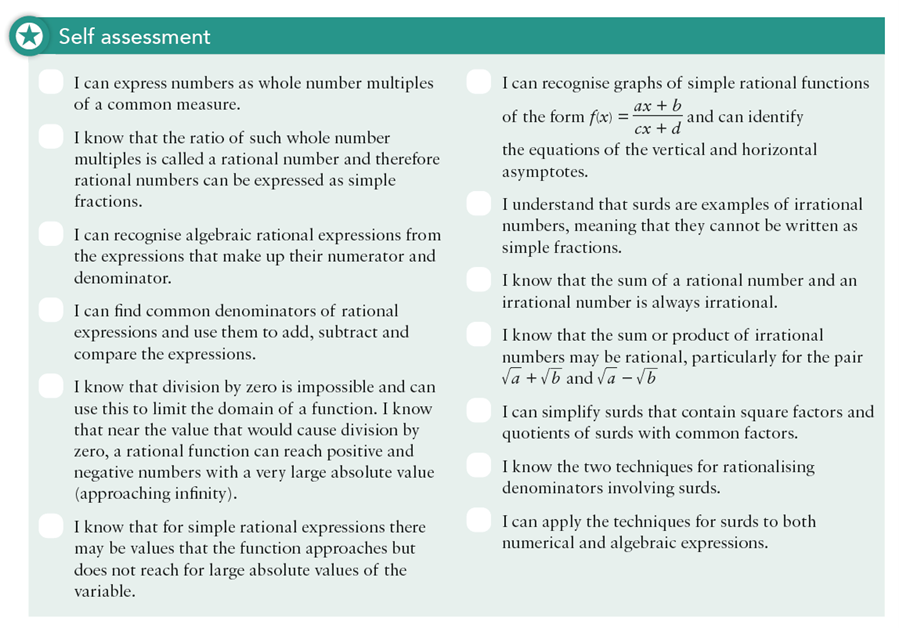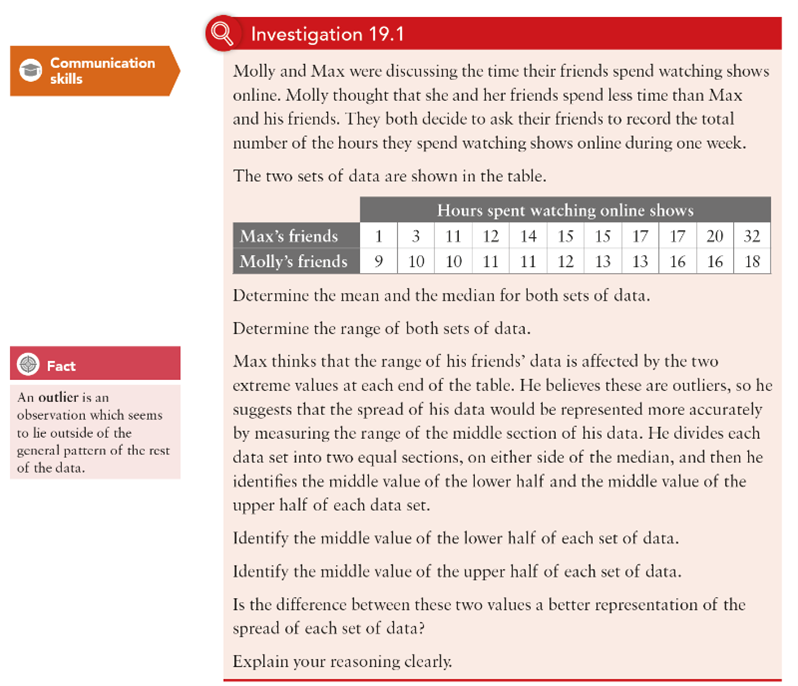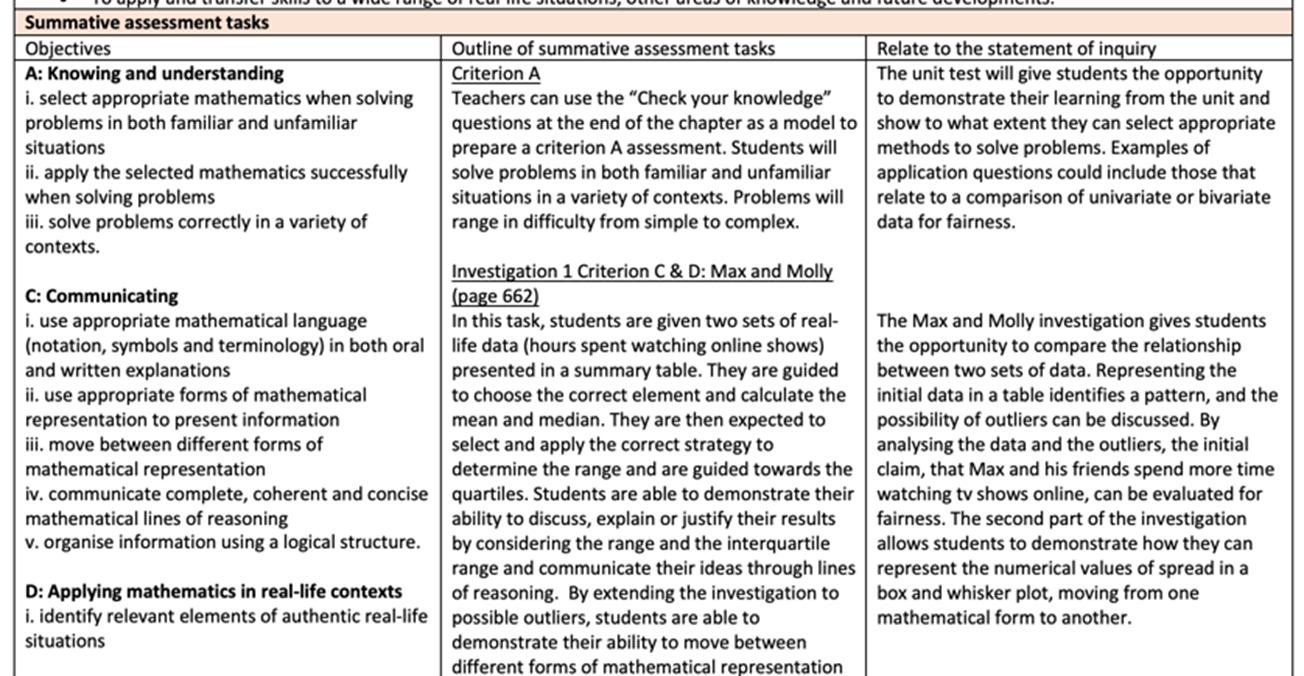
In the first blog post blog posts in this series, Paula Rowlands outlined how a smooth transition between the MYP and DP is supported by a seamless continuity between the components of the written curriculum and a concept-based inquiry approach within the taught curriculum.
In this final blog of the series, Paula discusses how the detailed consideration of assessment objectives and the carefully planned development of approaches to learning (ATL) skills can support the MYP to DP transition. She will also identify how the new Pearson Mathematics for Middle Years Programme series can support teachers when considering the assessed curriculum.
The importance of an interconnected system of teaching and learning
At the end of my previous post, I concluded with a reference to the interconnected nature of the written curriculum and the taught curriculum, highlighting that although the content progression must be considered carefully, how the concepts and content are introduced is equally important; a good curriculum must be implemented in the correct way.
However, these are not the only factors that affect the students’ progress. There are many other aspects that must be considered: the current level of their understanding and embedded skills, the feedback (Wiliam, 2016) and feedforward they receive (Burns, 2021), their ATL skills, etc. All of it works in harmony to help students to progress.
I like to think of the written, taught and assessed curricula as an interconnected web that supports the students and helps them to progress. If it is constructed correctly the students shouldn’t fall through it. Students and teachers need to know where students are in their holistic learning journey, and where they need to go next. This is the same for any mathematics programme and at any level, therefore the transition from MYP to DP should consist of similar informative assessments, the nature of which will be dependent on the information being sought. The difference between MYP and DP assessment arises in the nature of the summative assessments, and this is where a conscientiously planned transition needs to be considered.
Ensuring continuity of assessment from MYP to DP
The main areas we need to consider when developing the assessed curriculum in both MYP and DP are:
- The current level of a student’s understanding and skill set – where are they in terms of their mathematics and what do they need to do to progress?
- The development stage of a student’s ATL skills – are they developed enough to be able to access the curriculum we are sharing with them?
- How we can determine if the unit objectives have been met? This is not only a measure of how students have developed in line with objectives, but also a measure of how the planned unit met the objectives.
Points 1 and 2 are common for both programmes and ensuring a comprehensive system for both in an MYP curriculum will automatically ensure a seamless transition to DP. The third point, however, will be different for the MYP and the DP and this is the area that can cause a perception of discontinuity between the two programmes in terms of assessed curricula.
Formative assessments – Conceptual understanding
The first two areas identified in points 1 and 2 above, are best served by formative assessments, the embedded tasks incorporated into classroom practice that allow us to determine a student’s level of conceptual understanding or the level of their ATL skill development; these specifically help us decide the direction of teacher guidance (James, Embedding Formative Assessment in Classroom Practice, 2017). The approaches to formative assessment in both the MYP and DP should be of a very similar nature, and research articles published in support of the incorporation of formative assessment tasks into the classroom are plentiful (Black, 2018). In support of this, the Pearson series includes frequent formative tasks, including a pre-unit self-assessment “Do you recall?” section, Figure 1, a post-unit self-assessment checklist task, Figure 2, and many opportunities for practice tasks, Figure 3:



From Pearson Mathematics for the IB Middle Years Programme Years 4&5 Standard book
Formative assessments – ATL skills development
In the MYP and the DP only mathematical understanding is monitored through objective assessment, in both programmes summative ATL skill assessment is not a component part of the assessed curriculum. The only requirement for ATL skill development is a progression detail, but in the Principles into Practice guide it states, “Teachers should provide students with regular, specific feedback on the development of ATL skills through learning engagements and that provide formative feedback” (International Baccalaureate Organization, 2015). So, there is a requirement for explicit teaching of these skills across the whole school curriculum and a requirement for formative assessment and feedback within the MYP programme.
I believe the ATL skill set is the bridge that allows students to enter the world we have opened for them and agree with the IB statement, “ATL skills help students prepare for, and demonstrate learning through meaningful assessment. They provide a common language that students and teachers can use to reflect on, and articulate on, the process of learning”. (International Baccalaureate Organization, 2015). There is a danger that it becomes a lesser aspect of the curriculum planning which results in it being slotted in around everything else, but I would argue that it is a fundamental, in the true universal sense of the word. Opportunities for “learning how to learn” should be incorporated into the written, taught and assessed curriculum (James, Assessing and learning, and learning to learn., (to be published, 2022)).
It is interesting to note that the DP Subject Guides for Mathematics do not refer to the ATL skills as a separate entity, the Guides refer to the combined “Approaches to the teaching and learning of mathematics” (IB DP AA and AI, 2019), implying a support for my observation that the progress of a student within mathematics is dependent on all things equally, a dynamic system which can be affected by small changes. In support of the incorporation of ATL skill development and opportunities for formative feedback, the Pearson MYP Maths series includes reference to specific tasks where a student can be encouraged to develop their skills or demonstrate the level of their skills. Although a very useful aspect for students to think and reflect on how they are learning, incorporation of ATL labels within the chapters allows teachers to identify opportunities to plan and directly address the ATL skills that are required for the chosen summative assessment, Figure 4. This is supported further in the Teacher Guide unit plan, the key ATL skills that are required to access the suggested summative assessments are also highlighted, providing an example for teachers as they prepare their units, Figure 5.

From Pearson Mathematics for the IB Middle Years Programme Years 4&5 Standard book

From Pearson Mathematics for the IB Middle Years Programme Years 4&5 Teacher Guide
The third point from my list of assessment considerations is determined by summative assessment at the end of a unit. Although it could be argued that it is formative assessment, at this stage any changes to the unit plan would not benefit the current students. For the purposes of discussing the smooth transition from MYP assessment to DP assessment, I will treat these as summative tasks.
Summative assessment – MYP and DP: similarities and differences
For both the MYP and the DP summative assessment is criteria referenced. Summative unit assessments are assessed against MYP criterion descriptors and DP level descriptors with a final level awarded between 1 (lowest) and 7 (highest). In this respect the summative assessment is similar, but what is used as evidence to determine the final grade descriptor differs. The MYP approach assesses a student’s level against each strand of the 4 criteria at least twice in a year, and the sum of their criteria levels is compared with the final level descriptors. The assessment of individual criteria levels (from 1 to 8) is at the discretion of the teacher and moderated by grade teams, however there are defined grade boundaries to be used when comparing their total score to the grade descriptors.
For the DP, although the student’s final attainment level corresponds to a descriptive summary, their score is determined by particular and detailed examination marking, for example method marks and accuracy marks, and the total mark corresponds to a grade level descriptor. There is a different assessment approach here between the two programmes, however the MYP Guide states, “The MYP mathematics objectives and criteria have been developed with both the internal and external assessment requirements of the DP in mind” (IB MYP, 2020). In theory there should be a smooth transition between the two programmes, but it can give rise to some confusion for students and teachers, why is this?
When starting the DP course, it is important to share the above information regarding how the work is assessed differently and, in my experience, students adapt quickly to the changes in DP. However, when comparing the grade descriptors for the two programmes, it becomes evident that this could be the cause of the observed confusion and discrepancy between the assessment of the two programmes. Although both refer to grades from 1 to 7, the descriptions for each level are different. MYP descriptors refer to a student’s critical and creative thinking skills, the quality of their work in terms of sophistication, their ability to apply their knowledge and skills within familiar and unfamiliar situations and real-world situations. MYP Level 7 has a requirement of evidence of a nuanced understanding of concepts and contexts. In contrast, the DP grade descriptors are focussed on the knowledge and understanding of the syllabus, problem solving, mathematical connections and the use of technology. If the levels are the same between the programmes, i.e., between 1 and 7, there is potential for a misunderstanding that a given level in MYP automatically equates to the same level in the DP. It is essential from the start of the MYP course that students are aware of the descriptors and how this relates to their current skills set. In their minds they will have a description that corresponds to a level number, but it won’t be the same descriptor at DP. This can lead to frustration; students may not always understand that they need to demonstrate different skills at DP for a given level. Sharing the grade level descriptors for the DP assessments at the start of the course and highlighting the differences will make students more aware of the areas they need to develop during the course and help to smooth the transition.
The main aim of the assessed curriculum of the DP course, in terms of summative assessment, is the preparation for the external examinations and supporting students with their internal assessment. For MYP the nature of the summative assessment is dependent on the unit being followed, and for some schools who choose the e-assessment option, preparation for the online e-assessment. The MYP summative assessments will reflect the achievement level of students in the unit, and we design our assessments accordingly. However, as teachers we also know that even though in theory, we should be able to enter our students for summative assessments and they will be prepared from our class tasks, in practice this isn’t always the case; we owe it to our students to help them prepare for the external assessments that are a current aspect of the IB examination system. The IB alludes to this in their points to consider when supporting a smooth transition from MYP to DP, “preparing students to develop effective strategies for external examinations as well as inquiry-based learning across all mathematics courses” (IB MYP, 2020), but what does this mean in practice? Here are 10 small changes to MYP classroom summative assessment practices (PDF) that I have found help to smooth the transition from MYP to DP within the assessed curriculum.
The Pearson series contains investigations which can be used as MYP summative assessments. This is supported with unit plans that connect the suggested summative assessment task to the global context, the key and related concepts and the statement of inquiry, Figure 6 and Figure 7:

From Pearson Mathematics for the IB Middle Years Programme Years 4&5 Standard book

From Pearson Mathematics for the IB Middle Years Programme Years 4&5 Teacher Guide
Supporting a successful transition from MYP to DP mathematics – concluding observations
Throughout this series of blog posts I have highlighted areas of similarity between the MYP and DP mathematics programmes, identified areas of potential discontinuity and provided suggestions for how to minimise the effect of subtle differences to smooth the transition. A key observation point has been the need for a well-planned approach. As I noted earlier in this blog, everything that must be considered in terms of supporting students’ learning is formed into an interconnected web of the written, the taught and the assessed curriculum. Whilst the inquiry-based classroom can be a liberating place to learn, it can only be successful if it is supported by a well-planned, comprehensive curriculum with relevant assessment tasks and carefully planned learning activities that are supported by evidence-based research.
I hope that the blogs have conveyed the importance of considering what, when and how to incorporate concepts and skills into a school’s mathematics curriculum to ensure that all students are successful, and the aims of the MYP and DP are met. The MYP Guide puts this succinctly, “In mathematics, learning is generally sequential. Success in later mathematics courses relies on building fundamentals in earlier ones. Not only content but also teaching methods, assessments and problem-solving strategies need to be sequenced appropriately” (IB MYP, 2020). The new Pearson MYP Maths series is designed to support teachers in ensuring the correct content sequence, inquiry-based learning, and directed assessment, all provided in its own interconnected web of textbooks and additional support material.
Works Cited
Black, P. W. (2018). Classroom assessment and pedagogy. Assessment in Education: Principles, Policy & Practice, 25(6), 551-575.
Burns, E. M. (2021, September). The role of teacher feedback-feedforward and personal best goal setting in students’ mathematics achievement: A goal setting theory perspective. Educational Psychology, 41(7), 825-843.
IB DP AA and AI. (2019). IB Diploma Program – Mathematics: analysis and approaches guide 2019. International Baccalaureate.
IB MYP. (2020). Middle Years Program – Mathematics Guide 2020. International Baccalaureate.
International Baccalaureate Organization. (2015). MYP: From principles into practice. IBO.
James, M. ((to be published, 2022)). Assessing and learning, and learning to learn. In R. R. Tierny, International Encyclopedia of Education 4th edition. Oxford Elsevier.
James, M. (2017). Embedding Formative Assessment in Classroom Practice. In R. Maclean, Life in Schools and Classrooms. Education in the Asia-Pacific Region: Issues, Concerns and Prospects (Vol. 38). Singapore: Springer.
Pearson. (2021). IB Middle Years Mathematics Series. Pearson.
Wiliam, D. (2016, April 1). ASCD.com. Retrieved October 2021, from https://www.ascd.org/el/articles/the-secret-of-effective-feedback
Sign up to receive our blog updates
Like what you read and want to receive more articles like this direct to your inbox? Subscribe to our blog and we’ll send you a fortnightly digest of the blog posts you may have missed, plus links to free resources to support your teaching and learning.

